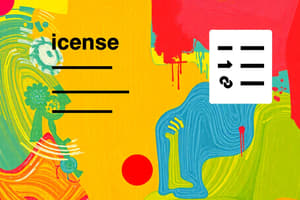Podcast
Questions and Answers
Which of the following is the MOST accurate description of compliance in a business context?
Which of the following is the MOST accurate description of compliance in a business context?
- A one-time assessment of a company's operational efficiency.
- Adhering to regulations, standards, and internal policies at all organizational levels. (correct)
- A reactive measure taken after legal issues arise.
- Exclusively focusing on external audits and certifications.
Why is traceability considered essential for compliance in a project?
Why is traceability considered essential for compliance in a project?
- It primarily focuses on preventing project delays rather than ensuring compliance.
- It reduces the need for internal audits.
- It enables the project manager to oversee the compliance status effectively. (correct)
- It is only relevant in projects following Agile methodologies.
What distinguishes verification from validation in the context of project management?
What distinguishes verification from validation in the context of project management?
- Verification focuses on customer needs, while validation ensures adherence to regulations.
- Verification and validation are interchangeable terms with no distinct differences.
- Verification is an external process, while validation is internal.
- Verification confirms that completed work satisfies regulations and specs, while validation certifies components meet customer needs. (correct)
In what primary way does compliance differ from a requirement in a business setting?
In what primary way does compliance differ from a requirement in a business setting?
What is the combined impact of compliance and verification on a business?
What is the combined impact of compliance and verification on a business?
Which of the following is NOT one of the essential steps for achieving compliance?
Which of the following is NOT one of the essential steps for achieving compliance?
How does independent validation contribute to stakeholder confidence?
How does independent validation contribute to stakeholder confidence?
Why should compliance be considered as a project requirement early in the project lifecycle?
Why should compliance be considered as a project requirement early in the project lifecycle?
How should a project manager view regulations when managing compliance as organizational process assets?
How should a project manager view regulations when managing compliance as organizational process assets?
What is the key difference in how compliance verification is approached in Waterfall versus Agile methodologies?
What is the key difference in how compliance verification is approached in Waterfall versus Agile methodologies?
Which of the following is a potential benefit of robust compliance processes for organizations?
Which of the following is a potential benefit of robust compliance processes for organizations?
What is one of the potential downsides or challenges associated with implementing compliance and verification processes?
What is one of the potential downsides or challenges associated with implementing compliance and verification processes?
Which of the following is a key compliance procedure in quality management systems?
Which of the following is a key compliance procedure in quality management systems?
What role do automated monitoring tools play in ensuring compliance?
What role do automated monitoring tools play in ensuring compliance?
What benefit do software solutions provide by centralizing data for compliance management?
What benefit do software solutions provide by centralizing data for compliance management?
How is automation improving compliance processes?
How is automation improving compliance processes?
In the context of compliance and verification, what is the role of AI integration?
In the context of compliance and verification, what is the role of AI integration?
How do data analytics enhance compliance monitoring?
How do data analytics enhance compliance monitoring?
In a project management context, why is it important to clearly define roles and responsibilities with defined access rights?
In a project management context, why is it important to clearly define roles and responsibilities with defined access rights?
Which of the following best describes 'Operational Efficiency' as a benefit of robust compliance?
Which of the following best describes 'Operational Efficiency' as a benefit of robust compliance?
Flashcards
Compliance
Compliance
Adhering to regulations, standards, and internal policies at all organizational levels.
Verification
Verification
A quality assurance process confirming completed work meets requirements; ensures traceability and prevents costly recalls.
Verification (Internal)
Verification (Internal)
Confirmation that completed work satisfies regulations and specifications; an internal process.
Validation (External)
Validation (External)
Signup and view all the flashcards
Requirement
Requirement
Signup and view all the flashcards
Compliance
Compliance
Signup and view all the flashcards
Regulatory Adherence
Regulatory Adherence
Signup and view all the flashcards
Reputation Management
Reputation Management
Signup and view all the flashcards
Customer Confidence
Customer Confidence
Signup and view all the flashcards
Define Processes and Operations
Define Processes and Operations
Signup and view all the flashcards
Ensure Information Availability
Ensure Information Availability
Signup and view all the flashcards
Monitor Processes and Operations
Monitor Processes and Operations
Signup and view all the flashcards
Risk Mitigation via Validation
Risk Mitigation via Validation
Signup and view all the flashcards
Stakeholder Confidence
Stakeholder Confidence
Signup and view all the flashcards
Compliance Verification (Waterfall)
Compliance Verification (Waterfall)
Signup and view all the flashcards
Verification (Agile)
Verification (Agile)
Signup and view all the flashcards
Centralized Data
Centralized Data
Signup and view all the flashcards
Automated Monitoring
Automated Monitoring
Signup and view all the flashcards
Compliance Reporting
Compliance Reporting
Signup and view all the flashcards
Automation
Automation
Signup and view all the flashcards
Study Notes
- Compliance and verification are critical for organizations in today's business environment.
- Compliance and verification ensure quality, avoid legal issues, and maintain operational efficiency.
- Aims to provide project managers and professionals with a comprehensive overview of implementing compliance and verification measures in their projects.
Understanding Compliance
- Compliance involves following regulations, standards, and internal policies at all organizational levels.
- Establishing a comprehensive system that facilitates master audits and incorporates changes in processes is the best way to achieve compliance.
- Clear roles and responsibilities with defined access rights are important for maintaining compliance.
Understanding Verification
- Verification is a critical quality assurance process that confirms completed work meets specified requirements.
- Traceability is essential for compliance in a project, allowing the project manager to oversee compliance status.
- Effective verification processes can prevent costly recalls and project delays.
Verification vs. Validation
- Verification confirms completed work satisfies regulations and specs and is an internal process.
- Validation certifies components meet customer needs and is an external process.
Requirements vs. Compliance
- A requirement is a condition or capability to satisfy a contract or standard and includes stakeholder expectations.
- Compliance is conformity in fulfilling official requirements, matching rules and regulations.
Impact on Business
- Compliance ensures adherence to regulations and verification confirms specified requirements are met.
- Together, compliance and verification safeguard a company's reputation and foster customer trust.
- Regulatory adherence ensures all business operations comply with relevant laws.
- Reputation management includes protecting the company's image through reliable practices.
- Customer confidence is built by consistently delivering quality products.
Essential Steps for Compliance
- Establish clear, well-documented processes and operational procedures to ensure all team members understand their roles and contributions to compliance efforts.
- Well-defined processes make it easier to identify and address potential compliance gaps.
- Guarantee the availability of all necessary information for audits and reviews.
- Implementing data management systems and access controls ensures data is accessible to authorized personnel.
- Regularly backing up critical data prevents loss.
- Implement robust monitoring systems to track the effectiveness of compliance measures.
- Performing regular audits, inspections, and performance reviews identify areas that need improvement.
- Setting up alerts for deviations from compliance standards ensures that problems are addressed quickly.
Validation: The External Perspective
- Verification is internal, validation is an external process that confirms components, products, or services meet customer needs.
- Written confirmation is required to demonstrate formal compliance protocols were followed in many jurisdictions.
- Implementing a verification/validation process can save producers from the financial burdens of expensive recall campaigns, rework, and project delays.
- Validation provides an unbiased assessment of compliance, ensuring adherence to industry standards and regulatory requirements.
- Independent validation increases stakeholder confidence, enhances reputation, and improves trust with customers, partners, and regulators.
Managing Compliance
- Compliance should be considered as a project requirement.
- Incorporating compliance into the project scope traces efficiently.
- Document early elements pointing to WBS additions.
- Consider compliance as organizational process assets.
- Regulations should be viewed holistically and teams need to concentrate resources to ensure consideration of assets.
Waterfall Methodologies
- In Waterfall, compliance verification occurs at the end of each phase.
- This approach allows thorough inspection and validation against predefined requirements before advancing.
Agile Methodologies
- In Agile, verification happens continuously throughout the project lifecycle.
- Short, iterative cycles enable constant assessment of new features against regulations and customer needs, promoting faster feedback and adaptation.
Benefits of Robust Compliance
- Effective compliance processes help avoid costly recalls, rework, and legal penalties.
- Adhering to regulations and standards helps projects and organizations can protect themselves from legal liabilities and ensure adherence to industry requirements.
- Compliance measures drive improvements in product and service quality by establishing clear standards and processes for verification and validation.
- Streamlined compliance processes lead to increased efficiency and reduced waste, optimizing resource utilization and project delivery.
Downsides: Challenges & Potential Drawbacks
- Compliance and verification can be costly, complex, and time-consuming.
- Bureaucracy and rigidity can stifle agility and innovation.
- Significant investment in resources and training are needed.
- Lengthy implementation and ongoing monitoring are needed.
- Navigating intricate regulations and procedures is necessary.
Key Compliance Procedures in Quality Management Systems
- Maintaining clear and accurate records of processes through documentation.
- Conducting regular assessments to ensure standards through audits.
- Providing employees with necessary skills and knowledge through training.
- Implementing measures to prevent errors and fraud through internal controls.
Tools
- Implementing software solutions that provide centralized data management enables easy access and traceability of compliance-related information.
- Automated monitoring tools track key metrics, identify potential issues, and generate real-time alerts for compliance deviations.
- Software simplifies reporting tasks by automatically generating reports and dashboards, demonstrating compliance efforts to stakeholders.
The Future
- Automation increases efficiency through automated systems.
- AI Integration can predict potential compliance issues.
- Data Analytics enhances monitoring via data-driven decisions.
Studying That Suits You
Use AI to generate personalized quizzes and flashcards to suit your learning preferences.




